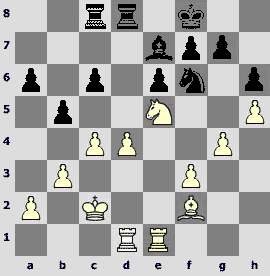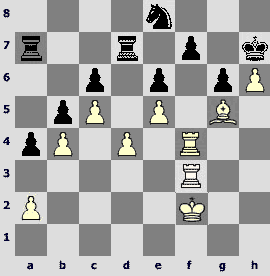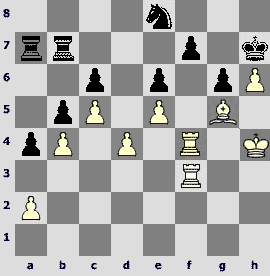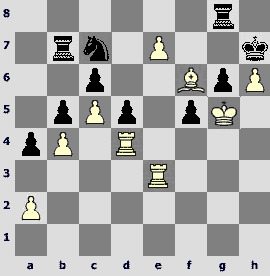14.06.2005
Michal Krasenkow annotates
There are different kinds of chess beauty. A combination with sacrifices is beautiful, as well as a deep positional plan. There is a paradoxical beauty, when the Gordian knot of seemingly unsolvable problems is suddenly split with an unexpected tactical blow or a fine and hidden maneuver. And there is a beauty of logic, when a chessplayer paints his victory, utilizing hardly noticeable inaccuracies of an opponent. The game that you are going to see, dear reader, fits exactly into the latter category.
P.Smirnov – K.Sakaev B19
Dagomys 2005
1.e4 c6 2.d4 d5 3.¤c3 dxe4 4.¤xe4 Ґf5 5.¤g3 Ґg6 6.h4 h6 7.¤f3 ¤d7 8.h5 Ґh7 9.Ґd3 Ґxd3 10.Јxd3 e6 11.Ґf4 ¤gf6 12.0-0-0 Ґe7 13.ўb1 0-0 14.¤e4 ¤xe4 15.Јxe4 ¤f6 16.Јe2 Јd5 17.¤e5 Јe4 18.Јxe4 ¤xe4 19.¦he1 ¤f6 20.g4 ¦fd8

Is this a joke? Where is the commentary? The answer is simple – see theoretical books and articles. All those moves have occurred in chess practice dozens times. The endgame is not as drawn as it might seem at the first glance. Yes, Black has no weaknesses, but White stands more «elevated», not only in the center, but also on the kingside, which is very important. The h5-pawn fixes potential objects of attack on g7 and h6. There are not too many pieces left on board, but there are some, and the remaining pair of knights is an important factor in positions with a space advantage. My conclusion: White can play for a win, and the practice shows that it is achievable.
21.f3. This prophylactic move is a prelude to a long maneuvering aimed at accumulating on small advantages. In other games White played 21.c3, 21.¦d3 and instant 21.c4.
21...Ґd6. Black also waits. Of course, 21...c5 is possible (Lutz – Khenkin, Bundesliga 2002), but White's pawn advantage on the queenside in the resulting position will be a serious advantage. Kramnik against Shirov (Russia – World rapid match, 2002) and Topalov against Akopian (Wijk aan Zee 2004) played 21...¦ac8 followed by с6-с5, but did not equalize, too. One could try exchanging knights – 21...¤d7 – White should decline this exchange by 22.¤c4 (Ginzburg-An.Bykhovsky-junior, Ashdod 2003). Dreev's idea to play 21...a5 and reply to 22.c4 with 22...¤d7 is interesting; however, I would think about 22.a4. The text move creates a threat of 22...¤d7 with simplifications.
22.Ґe3. White wants to block the с6-с5 break.
22...¦ac8 23.c4 a6. Vishy Anand played 23...a5 in a famous game against Kasparov (Linares 2003), but it turned out that the endgame after 24.a4 ¤d7 25.Ґd2 Ґc7 26.Ґc3 ¤xe5 27.dxe5 c5?! 28.ўc2 ¦xd1 29.ўxd1 ¦d8+ 30.ўe2 ¦d7 31.f4, followed by ¦а1-а3-b3, is far from being drawn. Premature is 23...b5, as White turns to attacking the c6-pawn: 24.¦c1 a6 25.Ґf2 ўf8 26.¦e2 ¦c7 27.Ґg3 bxc4 28.¦xc4 ¤d5 29.¦a4 ¦b7 30.¦c2± (Drabke – Heinig, Seefeld 2003). On 23...¤d7 it makes sense to avoid exchanging of knights by 24.¤d3.
24.Ґf2 ўf8 25.ўc2 b5. One can play this, because white king has interposed the c-file.
26.b3 Ґe7. Black prepares с6-c5. 26...Ґb4 did not work in view of 27.¦e2 bxc4 28.bxc4 c5?! 29.¤d3 cxd4 30.¤xb4 ¦xc4+ 31.ўb3 ¦c3+ 32.ўa4 ¦xf3 33.Ґxd4 with clear advantage.

27.¦d3! Important prophylactic move.
27...¤e8. Now Black decides against 27...bxc4 28.bxc4 c5, because after 29.dxc5 ¦xd3 30.ўxd3 (30.¤xd3?! ¤d7) 30...Ґxc5 31.Ґxc5+ ¦xc5 32.ўd4 ¦c7 33.¦b1 he would struggle stopping the c-pawn.
There is a dilemma of worse positions – passive or active defense. Groundless activity only creates additional weaknesses. Passive defense may lead to a slow smothered death, and not many players can stand such a torture psychologically. One has to master both methods. By the way, while the specialists in a counter-attack (like Viktor Korchnoi) are recognized and admired by the chess community, the experts in a passive defense, such as Ratmir Kholmov and – in recent years – Bartlomiej Macieja – only provoke a skeptical reaction: «what a lucky guy!» Such an attitude is wrong! The ability to create maximum difficulties with converting an advantage for the opponent is just as important as the ability to conduct brilliant attacks.
Konstantin Sakaev decided to defend passively. Only a deep intuition could tell Black whether or not his defense is breakable. It seems the intuition has misguided the experienced grandmaster this time.
28.f4 ¤d6 29.¦f3. Too early is 29.c5 ¤e8 followed by ¤f6.
29...Ґf6?! The last chance to create a counterplay was 29...bxc4 30.bxc4 Ґf6. After 31.¦d3! с5! (bad is 31...Ґxe5 32.dxe5 ¤xc4 in view of 33.¦e4 ¦xd3 34.ўxd3 ¤a5 35.¦a4) 32.dxc5 Ґxe5 33.¦xe5 ¤xc4 34.¦e4 ¤a5 35.¦b4 White keeps a certain edge in the endgame, but Black should not lose with precise play, thanks to some good central outposts for his knight.
30.c5 ¤e8 31.g5! Ґxe5. Black loses after 31...hxg5 32.fxg5 Ґxe5 33.dxe5 (with idea g5-g6 or h5-h6), as well as in case of 31...Ґe7 32.f5!
32.fxe5. 32.dxe5 (with idea f4-f5) did not work out well for White: 32...¦d5 33.f5 exf5 34.gxh6 gxh6 35.Ґe3 ўg7 (otherwise after a loss of the h6-pawn the passer h5 becomes very scary) 36.¦g1+ ўh7 37.¦xf5 ¦c7, and Black holds. After the text Black is doomed to the eternal passive defense. But can White break the fortress?
32...hxg5 33.¦g1 ¦d7 34.¦xg5 ўg8. So, black knight must defend the g7 without even dreaming of a nice d5-square. What next?
35.¦g4 ўh7 36.Ґh4 a5

37.h6! The first surprise.
37...g6. It turns out that the pawn on h6 is taboo: 37...ўxh6 38.¦h3 ўh7 39.Ґe7+ ўg8 40.¦gh4 f5 41.exf6 ўf7 (41...gxf6 42.Ґxf6!) 42.fxg7 ¤xg7 43.Ґd6 ¦g8 44.¦h7 ўg6 45.Ґe5 with a decisive attack, or 37...gxh6 38.¦fg3 (with idea ¦g8 and Ґf6) 38...f5 (the only defense) 39.exf6 ¦f7 40.¦g8 ¦d8 41.¦g1, and after some more pawn moves – 41...b4 42.¦1g2 h5 43.¦g1 – Black appears in Zugzwang and has to let white king breaking into his camp, and then via f4 to e5. For example: 43...¦c8 44.ўd3 ¦d8 45.ўе3 (Zugzwang again!) 45...¦b8! 46.ўf4 ¤xf6! (the last chance!) 47.¦xb8 ¤d7+ 48.ўe4 ¤xb8 49.ўe5 ¤a6 50.ўd6 (worse is 50.ўxe6 ¦f4 51.Ґf6 ¤c7+) 50...¦f4! 51.¦h1 ¦xd4+ 52.ўxc6 ¦d2 53.ўb6 ¤xc5 54.ўxc5 ¦xa2 55.ўb5 ¦a3 56.¦b1 and White is winning.
Thus one has to decline the sacrifice. So what? A fortress is still unbreakable, isn't it?
38.¦gf4 ¦cc7 39.Ґg5 ¦a7 40.ўd3 ¦ab7 41.ўe2 ¦a7 42.ўf2 a4. An attempt to create a counterplay – 42...b4 43.ўg3 a4 – was in White's favor: 44.bxa4 ўg8 45.a5 ¦xa5 46.d5! exd5 47.e6ќ or 46...cxd5 47.c6 ¦a7 48.¦xb4, and Black loses. It is the first time we see the d4-d5 break – a cornerstone of White's plan...
43.b4

43...¦db7. It would be more stubborn to keep the rook on d7, in order to have an option of taking on d5 with the rook in case of d4-d5. The king should defend the f7-pawn: 43...ўg8! Still, in my opinion, the thematic pawn break would decide the game after a necessary preparation: 44.a3 (44.h7+ ўh8!) 44...¦ab7 and now:
a) 45.h7+ (this check is premature) 45...ўh8! (the pawn is taboo because of mating attack via the h-file, but now black knight is able to improve its position via g7) 46.d5 ¦xd5! 47.¦xf7 ¦xf7 48.¦xf7 ¦xe5 49.¦f8+ ўxh7 50.¦xe8 ¦f5+ 51.ўe2 ¦xg5 52.¦xe6 ¦g2+ 53.ўf1 ¦g3 54.¦xc6 ¦xa3 55.¦b6 ¦b3= or 46.¦h3 (to respond 46...¤g7 with 47.Ґf6) 46...¦d5 47.¦h6 ¦bd7 48.ўe3 ¦c7, and White has achieved nothing;
b) 45.ўg3! ¦a7 (or 45...¦d5 46.¦f1 – not 46.h7+ ўxh7 and there is no mate – 46...¦bd7 47.h7+ ўh8 48.¦xf7 ¤g7 49.Ґe7! ¤f5+ – otherwise 50.¦h1 – 50.¦1xf5 ¦xe7 51.¦xe7 gxf5 52.¦xe6ќ or 51...exf5 52.e6ќ) 46.¦f1! ¦ac7 47.¦f2! (Zugzwang, and the rook has to move from c7, because on 47...ўh7(h8) follows 48.d5! cxd5 49.c6!) 47...¦a7 48.h7+ ўh8 49.d5!? cxd5 (loses 49...¦xd5 50.¦xf7 ¦xf7 51.¦xf7 ¦xe5 52.¦f8+ ўxh7 53.Ґf4ќ) 50.c6! ¦dc7 51.Ґd8 ¦xc6 (51...¦c8 52.c7!) 52.¦xf7, and White is winning;
с) there is another plan: 45.ўe3 ¦a7 46.ўe4 ¦ac7 47.¦f1! (the same Zugzwang) 47...¦a7 48.h7+! ўh8 49.d5! cxd5+ (one can/t take on d5 with the rook, of course, and after 49...exd5+ White plays 50.ўd3, threatening 51.e6 – 50...¤g7 51.¦h4 ¤h5 – the only move – 52.¦f6! ¦ac7 53.¦xh5! gxh5 54.¦h6 f5 55.Ґf6+ ¦g7 56.e6 ¦ce7 57.¦xh5 f4 58.¦h6ќ) 50.ўd4 ¦ac7 (50...¤g7 51.c6! ¦dc7 52.ўc5 ¦a6 53.¦xf7 ¦cxc6+ 54.ўxb5 ¦cb6+ 55.ўc5 ¦c6+ 56.ўd4ќ) 51.c6! ¦xc6 52.¦xf7 ¦xf7 53.¦xf7, for example, 53...¦c8 54.¦e7 ¦c4+ 55.ўd3 ¦c8 56.Ґh4! ¦b8 57.ўd4 ¦c8 58.Ґf6+ ¤xf6 59.exf6 ¦f8 60.ўe5ќ.
Does this analysis exhaust all the opportunities in this position? And what do you think, dear reader?
Let's return to the game.
44.ўg3. Before undertaking a pawn break White improves his king's position. The reason for this maneuver will become clear in 8 moves!
44...¦c7 45.ўh4 ¦cb7. It is too late to return to d7: 45...¦d7 46.d5! cxd5 (forced), and the second weakness (passed pawn on c5) decides the game. These are exemplary variations:
a) premature is 47.c6 ¦dc7 48.Ґd8 ўxh6 49.Ґxc7 ¦xc7 50.¦xf7 ¦xc6 with unclear consequences;
b) one could try to prepare с5-с6 by 47.ўg4 ¦ac7 48.a3 (unclear is 48.c6 f5+! 49.exf6 ¦f7). Black seems to be in Zugzwang: 48...¦a7 49.c6 ¦dc7 50.Ґd8 f5+ (50...ўxh6 51.¦h3+ ўg7 52.Ґf6+ ¤xf6+ 53.exf6+ ўg8 54.ўg5ќ) 51.exf6 ¦f7 52.¦e3ќ; however, it is possible to play 48...ўg8! 49.h7+ ўh8 [after 49...ўxh7 the resulting rook endgame looks lost for Black: 50.¦h3+ ўg8 51.Ґf6 ¤xf6+ 52.exf6 d4 53.ўg3 ¦d5 54.¦fh4 ¦h5 55.¦xh5 gxh5 56.¦xh5, for example, 56...¦d7 57.ўf3 d3 58.¦h1 d2 59.ўe2 d1Ј+ 60.¦xd1 ¦xd1 61.ўxd1 ўf8 62.ўe2 ўe8 63.ўf3 ўd7 64.ўf4 ўc6 65.ўg5 ўd7 66.ўh6 ўe8 67.c6 e5 68.ўg5 ўd8 69.ўf5 ўc7 70.ўxe5 ўxc6 71.ўe4! ўd6 72.ўd4 ўe6 (72...ўc6 73.ўe5ќ) 73.ўc5 ўxf6 74.ўxb5ќ] 50.¦f2 (50.¦h3 ¦c6; 50.c6 f5+ 51.exf6 ¦f7) 50...¤g7! 51.Ґf6 ўxh7 52.¦h2+ ¤h5 (52...ўg8? 53.¦h6ќ) 53.ўg5 ¦c8 54.¦fh4 ¦g8, and Black holds;
c) 47.¦f1! (a correct plan; White wants to remove the rook from f4, in order to have the resource Ґg5-e3) and now:
c1) 47...¦ac7 48.c6!;
c2) 47...¦db7 48.¦4f3 ўg8 (48...¦c7 49.Ґd8 ¦d7 50.Ґb6ќ; 48...¦d7 49.c6 ¦dc7 50.Ґe3ќ – this is White's idea!)49.Ґe3 ¦c7 50.ўg5 ¦c6 51.h7+ ўxh7 52.¦xf7+ ¦xf7 53.¦xf7+ ўg8 54.¦b7ќ;
c3) 47...ўg8 48.¦4f3 ¦ac7 49.a3 (Zugzwang again!) 49...d4! (other moves are worse: 49...ўh7 50.c6; 49...¦c6 50.h7+ ўxh7 51.¦xf7+ ¦xf7 52.¦xf7+ ўg8 53.¦b7ќ; 49...¦a7 50.c6 ¦dc7 51.Ґe3 ¦a6 52.h7+ ўxh7 53.¦xf7+ ¦xf7 54.¦xf7+ ўg8 55.¦e7 ¤g7 56.ўg5ќ) 50.¦d3 ¦d5 51.ўg4 and with the help of his king White has to win this game.

46.d5! (finally!) 46...exd5. 46...cxd5 would lead to the positions that were analyzed above.
47.e6 f5. This is what Black aimed at when playing 45...¦cb7. However, it is hopeless to fight against two passed pawns ("e" and "h"). Of course, 47...fxe6 loses immediately 48.¦f8 ¦a8 49.¦3f7+ ¦xf7 50.¦xf7+ ўh8 51.Ґf4ќ.
48.¦e3 ¦a8 49.¦d4 ўg8 50.e7 ¤c7. White threatened 51.¦e6, and on 50...ўf7 White wins by 51.h7 ўg7 52.¦e6 ¦c8 53.Ґh6+ ўxh7 54.ўg5ќ.
51.Ґf6 ўh7 (51...¤e8 52.h7+! ўxh7 53.ўg5ќ) 52.ўg5. This is why the king came to h4!
52...¦g8

53.Ґg7 ¦a7. On 53...¤e8, White can play not only 54.Ґf8, but also 54.¦e6!
54.ўf6 ¦aa8 55.ўf7 ¤e8. Passive defense also did not help, as White would get the g6-pawn: 55...¦ac8 56.¦g3 ¦ce8 57.a3 ¤a6 58.¦d1 ¤c7 59.¦e1 d4 60.¦xg6 d3 61.¦xc6 ¤d5 62.¦ce6ќ. The «active» 55...g5 is refuted by 56.¦e5 ¤e8 57.¦xf5 ¤xg7 58.¦xg5ќ.
56.¦e6! ¤xg7 (56...g5 57.¦xc6 ¤xg7 58.¦g6ќ) 57.¦xg6 ¤h5 58.¦xg8 ¦xg8 59.e8Ј ¦xe8 60.ўxe8. The rest is easy.
60...f4 61.ўd7 f3 62.ўxc6 f2 63.¦d1 ¤f6 64.¦f1 ¤g4 65.ўxb5. An impressive journey of the king!
65...d4 66.c6 1-0
